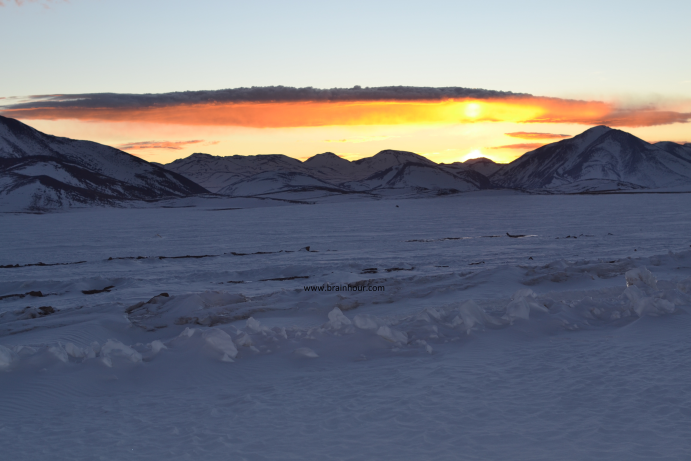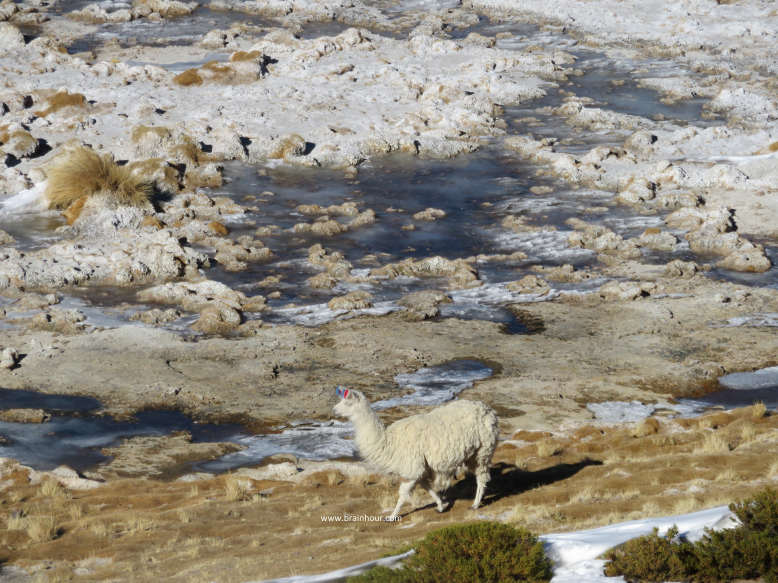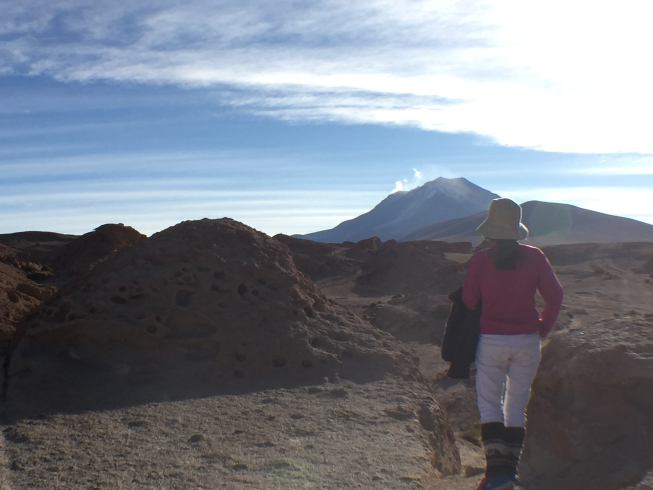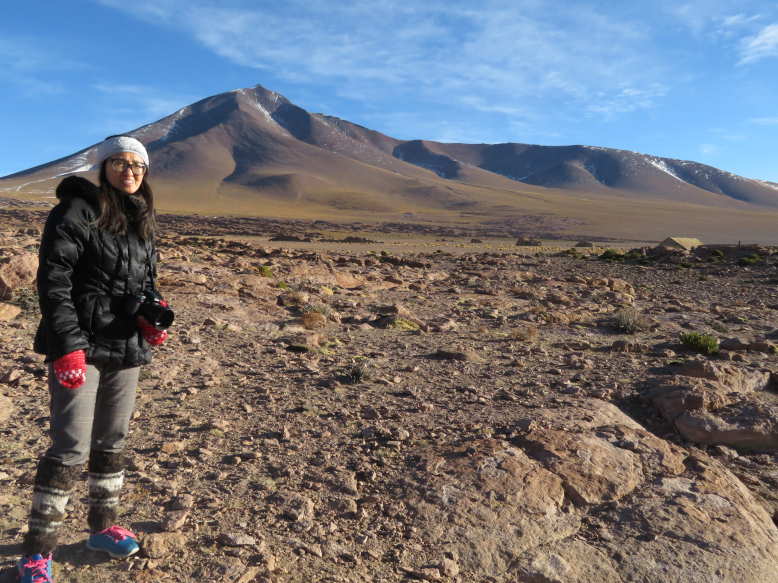 Volcano Uturunku
Volcano Uturunku
My whole 19-day Peru/Bolivia trip was centered around this ethereal Salar de Uyuni trip. This excursion was both challenging and exhilarating. To minimize the risk of altitude problem at 5000m we pushed the tour toward the end of our trip, giving ourselves plenty of time for acclimatization;I felt as normal as I could be for the entire trip. It also involved many grueling hours of endless miles bouncing, in a 4X4 jeep, over bumpy, rutted, sometimes non-existence, roads and staying at basic accommodation with no heats at altiplano. Despite the physical discomfort, we were greatly rewarded with the otherworldly views and wildlife that had permanently ingrained in my mind. Words can't fully describe how these surreal breathtaking scenaries have on human five senses.
 The spaniard ruin site
The spaniard ruin site
Day1
The breakfast at hotel Mitrus was served at 7:35am while all Salar de Uyuni tours started at 7:55am. So we literally rushed through the breakfast. I wish they are as accommodating as the hotels in Machu Picchu that serve breakfast at 4:30pm for customers taking the first bus up to MP citadel at 5:30am.
Our group had five tourist/passengers, three of us plus a pair of love birds from French. We have one driver/tour guide. Normally the tour includes a cook as well. Ours doesn't. Six people in a jeep with two per row. Quite comfortable. Upon explanation, the places we will be staying will have a cook and also the lunch will be precooked the night before.
Our driver and also our tour guide speaks only Spanish. Luckily the French guy, Daniel, knew Spanish and hence automatically becomes our tour translator. His help was much appreciated.

We explored the canyon land outside of Tupiza region, southern Bolivia, border with Chile. The red rock formations from this region reminded me of Utah's Canyonland and also Ashes National Parks. But here it seems to offer more variation of landscapes and also at a higher altitude.
We slowly ascended from 2000 plus to 4000 plus meters above sea level.
With Boliviano 15 admission fees, we visited some ruin sites built by Spaniards. Judging by the size, the population of the town could easily be in the hundreds. The whole town was wiped out by a plague in late 18th century.. We were allowed to go inside the mining site through a tiny steep dark hole. Without headlight, none of us ventured further than 5 feet deep.
During the colonial time, they exploited all natural resources they could possibly find. Among others, the natural resources were gold and silvers. They were mostly shipped k to Spain for the majesty; the remaining was used locally for religious and personal adornment purposes. For example, the altar at San Francisco cathedral in La Paz was made of pure gold and appraised to be cost at 40 millions.

We ended the day by entering the Eduardo Avaroa Andean Fauna National Reserve.
Day2
 Our basic accommodation. Everyday we packed/unpack the luggage, loaded/unloaded to/from the jeep.
Our basic accommodation. Everyday we packed/unpack the luggage, loaded/unloaded to/from the jeep.
My alarm went off at 5:45am as we needed to depart at 7:30am right after breakfast for our next destination. We didn't stay at the same shelter each night therefore each night we unpacked and each morning we repacked.
Less than five minutes after i got out of the bed, my feet began to feel pain and frozen due to my summer running shoes despite my wool socks. But it was a good sign that I actually felt hungry, which indicated I was free of the altitude sickness.
The famed altiplano adventure began today: Eduardo Avaroa Andean Fauna National Reserve park.
We spent two full day roaming in this most protected region in the entire country. This high altitude expanse boasts a surreal collection of colorful lagoons, snow-capped volcanoes, hallucinogenic rock formations, bubbling hot springs, scorching hot geysers and windswept deserts.

Loved the various lagunas we visited. Some lakes contain minerals such as epsom salt and material for glasses used for windows. Laguna Verda is my favorite. It is in green color due to the high content of arsenic and copper and is complemented by the imposing presence of Lincancabur volcano.
Wind chill and wind gust at altiplano is bone biting. We didn't stay long in most of the lagunas for this reason.

Aguas Thermales de Polques: We spent 25min at the hot spring. Many ladies and gentlemen enjoyed it; i didn't as the thought of having no shower afterward cringed me.
 Somewhere up in the Andes mountains
Somewhere up in the Andes mountains


We safely arrived at our shelter at 8:30pm.
Day3:
Despite Bolivia's wealth of natural resources, she is still a very poor country. This paradox remains an enigma for me, granted Bolivia is not a simple country to examine.

After breakfast, we headed straight to bloody red Laguna Colorada. The amazing bloody red coloration is caused by red sediments and algae in the water. The lake also attracts the James’, Chilean and Andean flamingos, the latter being the rarest flamingo species in the world.
 Laguna Colorada dotted with flamingos.
Laguna Colorada dotted with flamingos.

Arbol de Piedra: Some unusual lava rock formations due to wind erosion. Beware of both the sun and wind burn in this area.
Sololi desert is a non-sandy desert and a part of Atacama desert in Chile. It amazed me that any animal, whether it be a bird or mammal, could sustain itself off so little vegetation in such a harsh environment
 Vicuna
Vicuna Llama.
Llama.

Laguna Cañapa is a popular lunch spot for good reason: flamingo
 Flamingo
Flamingo
 Fumarolic activity: puffing smoke from Volcán Ollagüe (5,868m)
Fumarolic activity: puffing smoke from Volcán Ollagüe (5,868m)
We spent lots of hours driving through snows and deserts. We reached Uyuni Salt Flat around 7pm - the earliest arrival time of all three nights. The temperature was higher, warmer but still freezing. The only "regret" I had in this trip was the inability to capture the most beautiful starry night at such a high altitude because I left my long-range camera lens at home. Below is what I found on the internet to prove my point.
blog comments powered by Disqus















